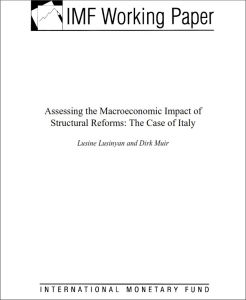Join getAbstract to access the summary!

Join getAbstract to access the summary!
Lusine Lusinyan and Dirk Muir
Assessing the Macroeconomic Impact of Structural Reforms: The Case of Italy
IMF, 2013
What's inside?
Italy can halve its euro-zone competitive gap through reforms in product, labor and service markets.
Recommendation
International Monetary Fund economists Lusine Lusinyan and Dirk Muir studied the impact of a wide range of economic reforms on Italy’s economy. Their report showcases simulations and reflects Muir’s work as an IMF researcher specializing in modeling. This combination of academic case studies and the IMF’s Global Integrated Monetary and Fiscal (GIMF) modeling predicts improvement in Italy’s economic growth rate given a comprehensive package of reforms. The caveat is that Italy must implement reforms quickly and effectively. All models have their limitations, and this one is no exception; important issues such as restrictive professional services, the dynamics of hiring and firing policies, and the reforms’ impact on energy prices, are “only approximate.” The report also doesn’t address the “unofficial,” underground Italian economy. getAbstract recommends this research to anyone who is doing business in Italy or who is curious about how a low-performing euro-zone nation really could turn things around.
Summary
About the Authors
Lusine Lusinyan and Dirk Muir are economists and researchers with the International Monetary Fund.


















Comment on this summary